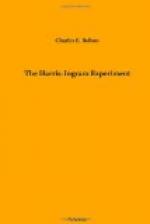Since electricity possibly travels on the surface of wires or metals, the Ingrams patented a valuable device of small corrugated copper tubes, strengthened in the center by steel wires, and thus the carrying capacity of electricity was greatly increased, and the amount of costly copper much decreased. These corrugated tubes enclosed in cheap glass, and surrounded with oil, were laid in properly prepared conduits of vitrified fire-clay sewer pipes. Without the intervention of the steam engine, by a surprisingly simple process, electrical force was liberated chemically at the mines and transferred for multiple uses at the steel plant. Expensive coal-freights were thus saved. All the slack coal was utilized, and instead of the waste of nine-tenths of the stored energy of the coal, only one tenth was now lost. To husband properly the fruits of so great a discovery, it was decided not to patent this latter invention, which if disclosed would give too great publicity to the details.
The electrical works at the mines were constructed of safe-steel walls and roof, and so built that the operations of generating electricity directly from coal were conducted in secret in several separate apartments, so that no single operator without the knowledge of all the initiated employees would be able to successfully work the inventions. The dozen initiated employees had made life long contracts with the company in consideration of liberal and satisfactory rewards. The Harris-Ingram Steel Co. thus equipped began operations.
CHAPTER XXIII
“GOLD MARRIES GOLD”
Alfonso Harris was content to leave his friends to continue their journey, as they were willing that he should return to the Netherlands, or to Amsterdam, where lived the beautiful woman who had won his heart.
Christine de Ruyter cordially welcomed Alfonso back to study art as he expressed it to her on the first evening after his arrival. Alfonso was much in Christine’s society, at art exhibits, in carriage drives, and on pleasure boat excursions down the bay. Weeks went by before he could summon courage enough to ask Christine’s hand in marriage.
In the game of hearts Alfonso thought himself an able combatant. He had studied Christine in action and in repose, in society, and when alone under his protection at Scheveningen, and at home, and he prided himself that he knew at least one woman thoroughly. She loved art, flowers, music, and fine dress, and was very ambitious. The latter trait was doubtless inbred from her distinguished naval relatives.
Christine had many acquaintances among the best families of Holland. Her beauty, coupled with the fact that she was an heiress, made her the object of much attention from artists and members of clubs, but possibly her love, or affection for art, might have sprung from the desire to gain more knowledge of how to make herself attractive in dress, manner, and conversation. Christine was not offensively vain, but she was passionately fond of admiration. Alfonso had never dreamed that Christine was not genuine at heart. She appeared to him to make much of her American acquaintance, introducing him to her many friends, young ladies as well as young gentlemen, and always seemed to prefer his company to others.




